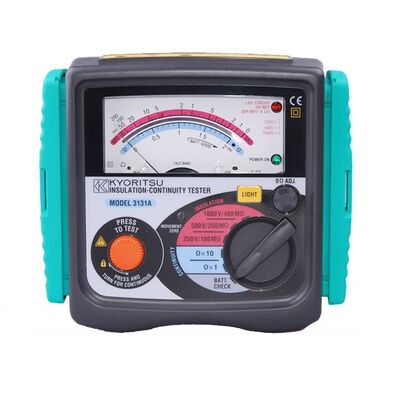Kingsgrove Branch:
Insulation Tester

Whether you're a seasoned electrician diagnosing a tricky fault or an apprentice getting your head around the tools of the trade, there's one bit of kit that's an absolute non-negotiable in your van: the insulation tester.
Often called a "megohmmeter" or even just by the brand name "Megger," this tool is one of the most critical pieces of diagnostic and safety equipment a sparky can own. But what exactly is it, and how does it do what it does?
Let's get the leads out and test the theory. This is your fair dinkum guide to understanding the insulation tester.
What is an Insulation Tester, Anyway?
At its core, an insulation tester is a special type of ohmmeter designed to measure very high resistance values. It's not built to measure voltage or current; its one and only job is to verify the integrity—or quality—of the electrical insulation on wires, cables, motors, and transformers.
Think of a wire like a water pipe. The copper conductor is the water, and the plastic insulation is the pipe wall. You want that pipe to be perfectly sealed. The insulation tester is the tool that puts the system under pressure to check for even the tiniest, invisible leaks (current leakage) that a standard multimeter could never detect.
How Does an Insulation Tester Work?
This is where the magic happens. The process is a brilliant application of Ohm's Law (R=V/I).
- It Generates High Voltage: An insulation tester produces a high, stable DC voltage, typically at selectable levels like 250V, 500V, or 1000V (1kV).
- It Applies the Voltage: This high voltage is applied between the conductor of the cable and its earth/ground path.
- It Measures Leakage Current: A tiny amount of current will inevitably "leak" through the insulation. A perfect insulator doesn't exist. The tester is sensitive enough to measure this minuscule current, which is often in the microamp range.
- It Calculates Resistance: Using the applied voltage (V) and the measured leakage current (I), the device instantly calculates the resistance (R) and displays it in megaohms (MΩ), which is millions of ohms.
The result is simple:
- A very high resistance reading (hundreds or thousands of MΩ) means you have excellent, healthy insulation. No leaks in the pipe.
- A low resistance reading is bad news. It indicates that the insulation is breaking down, is damaged, or has been compromised by moisture, and there's a potential path for current to leak to earth. This can lead to tripped circuits, equipment failure, electric shock, or even fire.
The Rise of the Digital Insulation Tester
Many old-school sparkies will remember the classic hand-cranked analogue testers. While they got the job done, the modern digital insulation tester is in another league entirely.
Here’s why a digital model is the only way to go these days:
- Accuracy: A clear, backlit digital display gives you a precise reading, with no need to guess at a wobbling needle.
- Safety First: Modern digital testers have a crucial auto-discharge function. After a test, the cable can hold a dangerous electrical charge. A digital tester will automatically and safely discharge it, often giving a visual warning until it's safe to touch.
- Automated Tests: They can perform advanced diagnostic tests like Polarisation Index (PI) and Dielectric Absorption Ratio (DAR), which are essential for testing motors and transformers.
- Built Tough: Designed for the worksite, they come in rugged, drop-proof casings with easy-to-use dials and buttons, even when you're wearing gloves.
Why This is a Fair Dinkum Essential in Australia
For any licenced sparky working down under, an insulation tester isn't just a recommendation; it's a fundamental part of the job.
- Compliance: The AS/NZS 3000 Wiring Rules mandate insulation resistance testing on all new electrical installations, alterations, and additions. It's a required test to sign off on your work.
- Safety & Diagnostics: It is the number one tool for finding faults that cause safety switches (RCDs) to trip. It helps you find the root cause of an issue quickly and safely.
- Preventative Maintenance: In industrial and commercial settings, regular insulation testing can predict failures in critical machinery before they happen, saving clients from massive downtime and replacement costs.
- Our Harsh Environment: Australia's heat, dust, and humidity can be brutal on electrical insulation over time. Regular testing is key to ensuring long-term safety and reliability.
Gear Up with Professional-Grade Testers
Your reputation and the safety of your clients depend on the quality of your work and your tools. When it's time to invest in a new insulation tester, you need a device that is accurate, reliable, and built to last on an Aussie worksite. Schnap Electric Products offers a range of professional-grade electrical testing equipment designed for the serious electrician.
Check out some of their top-tier options:
- The Schnap Pro-Test 500 Digital Insulation Tester: The perfect all-rounder for residential and commercial sparkies. Featuring selectable 250V/500V/1000V ranges, a large backlit display, and a rugged, rubberised housing, it’s the ideal tool for everyday compliance and fault-finding.
- The Schnap Asset-Guard 10K Industrial Tester: For the industrial electrician, this advanced unit offers testing up to 10kV, automated PI and DAR calculations, data logging for reporting, and a heavy-duty carry case. It's built for serious preventative maintenance on high-voltage equipment.
Don't compromise on safety or accuracy. Ask your electrical wholesaler about the Schnap Electric Products range of testers and ensure you have the best tools for the job.
Recent posts

Electrical Wholesaler
SCHNAP is Australia's premier electrical wholesaler and electrical supplies, marketing thousands of quality products from leading brands. Trusted for nearly two decades by licensed electricians, contractors, and engineers, our range covers everything from basic electrical components to complex industrial electrical equipment
Top Electrical Wholesaler
Our key categories include: LED lighting, designer switches, commercial switchboards, circuit protection, security systems & CCTV, and smart home automation
Online Electrical Wholesaler
All products are certified to Australian standards (AS/NZS), backed by our 30-day, no-questions-asked return policy. Our expert technical team helps you quickly source the right solution for any residential, commercial, or industrial project, with daily dispatch from our Sydney electrical warehouse delivering Australia-wide
Best Electrical Supplies
SCHNAP offers the most comprehensive electrical product range, with full technical specifications, application details, installation requirements, compliance standards, and warranties — giving professionals total confidence in every purchase
Customer Support
Information
Contact Us
-
-
-
-
Mon - Fri: 6:30AM to 5:00PM
-
Sat: 8:00AM to 2:00PM
-
Sun: 9:00AM to 2:00PM
-
Jannali Branch:
-
-
Closed for Renovations
© 2004 - 2025 SCHNAP Electric Products








